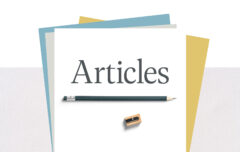A friend recently said something that disquieted me. He said that he assumes I make use of AI in creating the articles I post to this site or in selecting the articles I link to on other sites. I suppose it’s a fair assumption since so many people across so many fields are now relying on AI to do tasks they once performed themselves. But I think it’s important you know that I do not use AI in any way.
It’s important because so much information is now being created and provided by artificial intelligence. Websites are full of AI slop, and it is often difficult to trust the information they provide. The top results on Google are now usually AI-generated and, in my experience, often wrong. (Just yesterday, it assured me I had written a study guide for one of my books that most certainly does not exist.) While AI may increase the quantity of information that is being created and amplify our access to it, it is at the same time eroding our confidence in it. And what use is information if it is not trustworthy?
So I want you to know that every article on this site is written by me and is created without any use of artificial intelligence.1 Every item that appears in A La Carte has been found, read, chosen, and inserted by me, also without the use of any artificial intelligence. This is an old-school blog where a person does it all and does it all manually. There is a human authenticity to this site that I don’t ever intend to hand over to AI, even if that would somehow increase efficiency.
I thought this subject might lend itself to an explanation of the various tools I do use in the production of this site and its content. So here goes.
There is a human authenticity to this site that I don’t ever intend to hand over to AI, even if that would somehow increase efficiency.
The great majority of my writing is done on a MacBook. Because I travel frequently, a laptop allows me to take my entire production environment with me wherever I go. When I am in my home office I connect it to an external monitor to make it more like a “real computer.” I use a sit-stand desk and tend to stand and sit in roughly two-hour intervals.
I deal with significant repetitive motion pain, so am extremely deliberate with my input tools. I type on ZSA keyboards and currently use a Voyager whose key mappings have been heavily customized to reduce keystrokes, especially modifiers such as shift and command. It uses low-profile Kailh Choc Pro Red switches with blank key caps and silicon dampeners. My mouse of choice is the Logitech Mx Vertical. I use Savant Elite 2 foot pedals with the pedals mapped for scrolling. I also use a StreamDeck to provide one-tap access to a host of controls and shortcuts, all designed to reduce typing and therefore reduce wear and tear and the pain it brings.
I do most of my writing using Ulysses, though for book-length projects I organize manuscripts using Scrivener. Any writing project eventually leads to a Word document, but Apple’s Pages is sufficient, so I use that for going back and forth with an editor. My preferred font for writing is iA Writer Duospace. I use the free version of Grammarly to spellcheck my work and catch basic grammatical errors. I do not use any features of any app that rewrite or otherwise alter my text using AI.
I do most of my reading on a Kindle device using either Kindle or ePub versions. My highlights are automatically exported into ReadWise and from ReadWise into Roam Research, both of which are key elements of my system for remembering and re-encountering material I have read. I follow, read, and bookmark blogs, newsletters, and other types of content using ReadWise’s Reader app.
For Bible reading and basic study, I rely on an ESV.org subscription, while for advanced Bible study and sermon-preparation resources I use Logos. Any highlights in make in Logos also make their way into my system, though that process requires a bit more manual interaction.
For organization and communication I use the out-of-the-box Apple apps—Mail (for email), Calendar (for scheduling), Reminders (for task management), and Notes (for information management). This is a change from what I laid out in Do More Better, but since I wrote that book, these basic apps have gained much more sophisticated functionality and for my needs the alternatives are not worth the additional cost. Some key utilities I rely on include Alfred (which allows me to easily search my site, search ESV.org, customize copying and pasting, and much else); Keyboard Maestro (which provides access to many useful macros and shortcuts); and Magnet (since I am a bit obsessive about keeping my open windows consistent in their size and positioning).
My site uses a customized WordPress template that was expertly coded by Chad Helmer. It relies heavily on Jetpack and uses only a handful of other plugins.
Though I choose the quotes that appear in the daily quote graphics (and on SquareQuotes.church), they are created by a designer I contract for the purpose. I use Unsplash to find the majority of my stock photos and mostly use Canva for any graphics I need to create (e.g. the daily Kindle deal graphics you may see on X or Facebook). I am not knowingly using any AI-generated photos, though it is becoming increasingly difficult to discern the difference.
So those are the tools I use and, perhaps just as importantly at this stage in history, the tools I don’t use to create what you read at this site. What’s important for me to communicate is simply this: This site is an authentic expression of one person’s life and faith and I plan to always have it stay that way. At least as it exists now, AI has no place here.
- The exception is sponsored articles, which, by definition, are written by the sponsor. ↩︎










